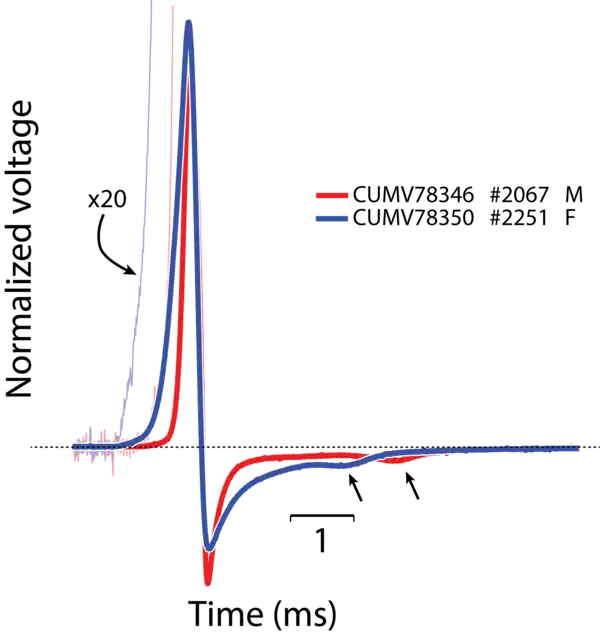Paramormyrops hopkinsi
Paramormyrops hopkinsi (Taverne and Thys van den Audenaerde, 1985) is a species of freshwater electric fish. It was discovered in the Ivindo River in Gabon, in west-Central Africa by Dr. Carl D. Hopkins of Cornell University.[1][3][4] It is distributed throughout the Ivindo River basin of Gabon and the Ntem River basin of Cameroon.[2] Described originally as a Brienomyrus in 1985[1] it was transferred to Paramormyrops in 2007.[5] The electric discharge has two phases: a head-positive phase followed by a head-negative phase. The mean duration of the EOD is 2.8 ms for females, 2.96 for males. The Fourier transform of the EOD peaks at 536 Hz for females, 468 for males. Both male and female EODs have a head-negative voltage bump about 5 to 6 ms after the main head positive phase (arrows).
| Paramormyrops hopkinsi | |
|---|---|
| Scientific classification | |
| Kingdom: | |
| Phylum: | |
| Class: | |
| Order: | |
| Family: | |
| Genus: | |
| Species: | P. hopkinsi |
| Binomial name | |
| Paramormyrops hopkinsi | |

References
- Integrated Taxonomic Information System (2004). "Brienomyrus hopkinsi Taverne and Thys van den Audenaerde, 1985". Integrated Taxonomic Information System. Retrieved September 27, 2007.
-
- Froese, Rainer and Pauly, Daniel, eds. (2011). "Paramormyrops hopkinsi" in FishBase. June 2011 version.
- Cornell University. "Hopkins Lab, Department of Neurobiology & Behavior, Cornell University". Cornell University. Retrieved September 27, 2007.
- Cornell University (1998). "The Biodiversity of Freshwater Fish in Gabon Rainforests, One Hundred Years After Mary H. Kingsley". Cornell University Department of Neurobiology and Behavior. Retrieved September 27, 2007.
- Stiassny, Melanie L. J.; Teugels, Guy G.; Hopkins, Carl D. (2007). Poissons d'eaux douces et saumâtre de basse Guinée, ouest de l'Afrique centrale. Paris: IRD Editions. pp. 294–7. ISBN 978-2-7099-1621-9.
Sources
- Cornell University (1998). "Brienomyrus hopkinsi - Photo by Dr. Carl D. Hopkins". Cornell University Department of Neurobiology and Behavior. Retrieved September 27, 2007.
- CTD's Brienomyrus hopkinsi page from the Comparative Toxicogenomics Database
- UniProt Taxonomy (2007). "Species Brienomyrus hopkinsi". UniProt Consortium. Retrieved September 27, 2007.